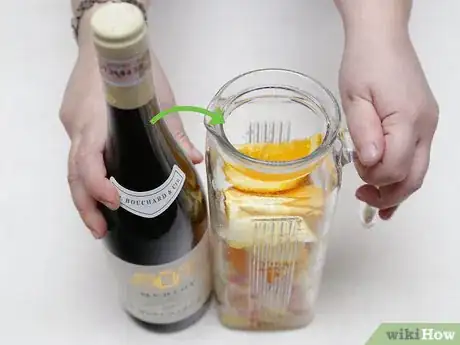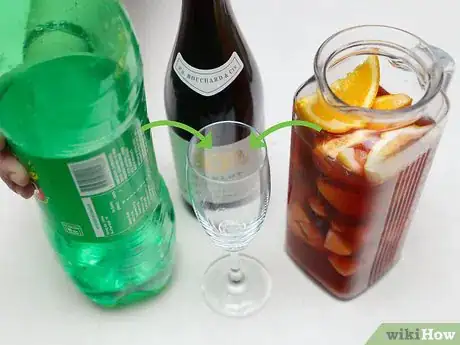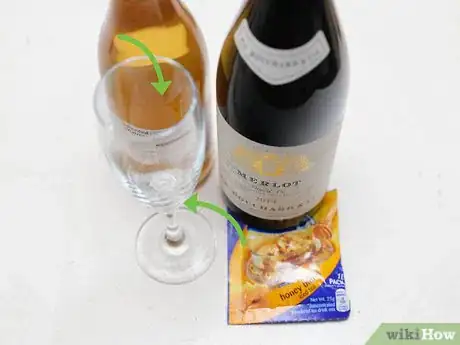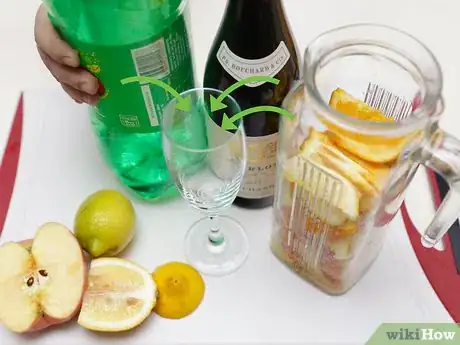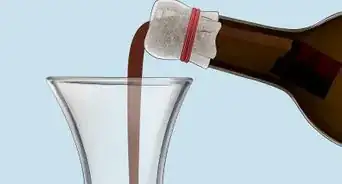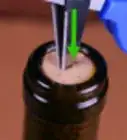This article was co-authored by Murphy Perng. Murphy Perng is a Wine Consultant and the Founder and Host of Matter of Wine, a business that produces educational wine events, including team-building experiences, networking events, and private parties. Based in Los Angeles, California, Murphy has served as a Wine Educator for clients such as Google, Buzzfeed, Tiktok, Snapchat, and Equinox and been featured on National Geographic and The Somm Journal. Murphy possesses her WSET (Wine & Spirit Education Trust) Level 3 Advanced Certification.
There are 10 references cited in this article, which can be found at the bottom of the page.
This article has been viewed 120,451 times.
Sangria is a melange of fruit and wine that tempts your taste buds in the way that only sangria can. Refreshing, customizable, and perfect for parties, a pitcher of sangria is when wine soaks in fresh fruit, taking on the sweetness and imparting an incredible bite to the fruit itself.
Ingredients
- 2-3 large Valencia oranges
- 1-2 limes
- 1-2 lemons
- 1 apple
- 2-4 tablespoons brown or cane sugar
- 1 bottle (1.5L) of Merlot or Spanish Roja
- 1/3 cup brandy
Steps
Making Traditional Red Sangria
-
1Chop up the citrus into 1/4-inch thick wedges and remove any large seeds. Keep the rinds on the fruit, as they will help flavor the drink later on. When choosing the amount of citrus, lean towards the oranges and use the lemon and limes lightly. Most people love to eat the fruit in the drink, but few people can handle a straight lemon or lime![1]
- The amount and variety of fruit you choose is up to you -- sangria is endlessly customizable.
- Lemon and lime are very acidic, which could be off-putting to certain guests. If you want to stay more on the safe side, try making it with orange.
-
2Core and apple and cut into bite-sized slices. Again, remove any seeds so that people can munch on the fruit without worrying about breaking a molar. Furthermore, seeds are usually bitter and can impact the final flavor.Advertisement
-
3Add the chopped fruit to the bottom of a pitcher with 2-3 tablespoons of sugar, then muddle for 45 seconds. Muddling is simply beating the fruit up a bit with a wooden spoon. This releases sugars and flavors that will work their way into the sangria.
-
4Add the splash of brandy and continue to muddle for another 20-30 seconds. Like all the other ingredients, you can adjust the brandy to match your taste, and you can add a few other liquids here if you'd like to try something new:
- Orange Liquor: Gives a nice, sweet little kick to the drink without water down the alcohol content.
- Orange Juice: Sweetens up the drink while adding a little more citrus. Also stretches out the drink a bit more and cuts some of the alcohol.[2]
-
5Add in the bottle of red wine, usually a Roja or a Merlot, and stir well. You want a light, refreshing white wine for the best sangria. Traditionally, sangria is made with a Spanish Roja, but most people substitute a nice Merlot without missing anything.
-
6Consider letting the drink chill for at least 3-4 hours to gain flavor. You can serve the Sangria as is if you add ice, or let it blend in the refrigerator for a few hours. The choice is yours. Either way, serve the drink on ice for a refreshing, wonderful burst of flavor. If you want, you can even leave the drink to blend overnight for the best flavor.
- Many recipes claim you must let it sit for 4 hours. While this will taste better, it is not strictly necessary.[3]
-
7Serve over "bubbles," adding a splash of carbonation right before serving. Everything is a bit more refreshing when it has some fizz to it, and Sangria is no different. Furthermore, this is just one more chance to customize your perfect version of the classic cocktail.
- Club Soda: Perfect if you like a little refreshing fizz in your drink. Add as much as you added brandy.
- Seltzer Water: Has a bit more pucker to it, making it a great choice to balance out too-sweet sangrias, in particular. You can even try flavored seltzers, like Lemon-Lime.
- Champagne or Prosecco: This is sangria, so go nuts! A bubbly, light, and crisp wine or prosecco will keep the drink strong and add a refreshing punch of bubbles.[4]
Trying Sangria Variations
-
1Go nuts with your fruit combinations. There is really only one rule when choosing fruits for sangria -- you want one citrus and one non-citrus. Apple and oranges are a classic combination, but far from the only one. Try out:
- Peaches
- Plums
- Pineapples
- Strawberries.
- Blackberries
- Blueberries
-
2Try a white wine sangria with new fruits and a dry, crisp white, like a Rioja or Pinto Gris. White wine makes incredibly refreshing sangria, especially when paired with a nice bubbly finish. In place of brandy, use a light liquor (apple, lemon, peach schnapps, vermouth.). That said, white wines tend to do better with different fruits than those used for red sangria. Try out:[5]
- Apples
- Lemons and Limes
- Peaches
- Grapefruit
- Fresh mint
- Raspberries
- Pears
- Strawberries
- Kiwis[6]
-
3Experiment with less traditional wine types. Sangria is not supposed to be complicated or set in stone. Knowing this, chefs and bartenders across the world are considering new bases for their drinks, including:
- Rosé: The bubbly pink drink mixes well with fruit and delivers all the bubbles right off the top. Be careful not to let it go flat before serving, however.
- Cava: Again, the bubbles are key, but this light and refreshing wine goes great, in particular, with blood oranges.
- Pinot Noir
-
4Try out other liquors. The addition of brandy traditionally complements a red sangria lightly, but it is not the only liquor that can pull it off. You want to choose a drink that has natural notes of fruit, or a light floral scent to it. Don't try something strong that will distract from the refreshing fruit notes. You could think about:
- Suze
- Cointreau
- St. Germain
- Schnapps
- Triple Sec[7]
-
1Blend the citrus juice with spices ahead of time for a smoother drink. Instead of chopping all of the fruit, juice oranges, lime, and lemon in a small saucepan; add 2-3 tablespoons caster sugar, a pinch of nutmeg, and a ground cinnamon stick and heat just until it steams, removing immediately and letting it cool before adding the wine.
- Heat liquid (whilst stirring) until steam rises from the surface - do not simmer.
- You place the pot in a larger pot filled with cool water in order to cool the juice faster.
Making Quick Sangria Variations
-
1Use orange juice and club soda for a simple, refreshing pick-me-up with a glass of wine. Don't want the full hassle of sangria, but want something lighter and refreshing than a straight glass of wine? Skip the fruit and hit the fruit juices, adding sweetness before topping with fizzy club soda. Add a couple of ice cubes and you're set to go:
- If you have some fresh fruit sitting around, you can still add it for a burst of flavor.
-
2Use frozen berries and sparkling water for a quick sangria made in the glass. This simple mixture will get you going in mere moments, and can still be customized easily. All you'll need to mix, in order, are:
- Frozen berries
- Ice
- Squeezed lemon, lime, and or orange juice to taste
- Red wine
- Sparkling water[8]
-
3Try a white wine and iced tea sangria. The tea takes the place of the liquor, providing a lightly herbal note to the drink. This pairs it well with almost any fruit and can be topped with a bit of basil for a light, unique garnish.
- Try this with mango, peach, lemon, and strawberry.[9]
- Use honey to sweeten the drink simply if you need a little sugar.
-
4Try a super-easy "campfire" sangria. This won't win you any style points, but campfire cocktails aren't supposed to be classy. All you'll need are three ingredients, mixed to your taste preferences. Three parts wine to one part soda is a good starting ratio:
- 1 box Red wine
- 1 2L bottle orange soda
- 2-3 pieces of fruit (lemons, apples, strawberries)[10]
Community Q&A
-
QuestionShould I puree the fruit?
 Ariesmoonscorpiosun23Community AnswerNo. Sangria has large pieces of fruit in it. You shouldn't puree the fruit but "muddle" it, which means mash it with a spoon.
Ariesmoonscorpiosun23Community AnswerNo. Sangria has large pieces of fruit in it. You shouldn't puree the fruit but "muddle" it, which means mash it with a spoon. -
QuestionCan I cook my fruit if i don't have a blender?
 Community AnswerGod no. You don't cook fruit for sangria. By cooking them, you lose the texture and flavor of the fruit. Just cut them up small, or use a potato masher instead.
Community AnswerGod no. You don't cook fruit for sangria. By cooking them, you lose the texture and flavor of the fruit. Just cut them up small, or use a potato masher instead.
Suggestion
- You can use a relatively cheap wine for this (<$10 Australian).
Expert Interview

Thanks for reading our article! If you'd like to learn more about making sangria, check out our in-depth interview with Murphy Perng.
References
- ↑ http://minimalistbaker.com/easy-traditional-red-sangria/
- ↑ https://www.thekitchn.com/how-to-make-sangria-cooking-lessons-from-the-kitchn-203517
- ↑ http://www.epicurious.com/recipes-menus/how-to-make-sangria-without-a-recipe-article
- ↑ http://www.epicurious.com/recipes-menus/how-to-make-sangria-without-a-recipe-article
- ↑ http://www.bonappetit.com/recipe/sangria-blanco
- ↑ http://www.foodnetwork.com/recipes/rachael-ray/white-sangria-recipe.html
- ↑ http://www.bonappetit.com/test-kitchen/common-mistakes/article/how-to-make-sangria
- ↑ http://www.wellfedhomestead.com/homemade-sangria-with-honey
- ↑ http://kirbiecravings.com/2014/06/iced-tea-sangria.html
About This Article
To make traditional red sangria, chop up 2-3 large oranges, 1-2 limes, and 1-2 lemons into 1/4 inch pieces and leave the rinds on for flavor. Then, remove the apple core and seeds before chopping it into bite-sized pieces. Add the fruit to the bottom of a pitcher with 2 to 3 tablespoons of sugar and beat with a wooden spoon for 45 seconds. Pour 1/3 cup of brandy in and stir for 30 seconds, then add a 1.5L bottle of Roja or Merlot wine and stir well. Let the drink chill for 3-4 hours, then serve! For sangria variations, as well as a sangria that doesn't require chilling, read on!




